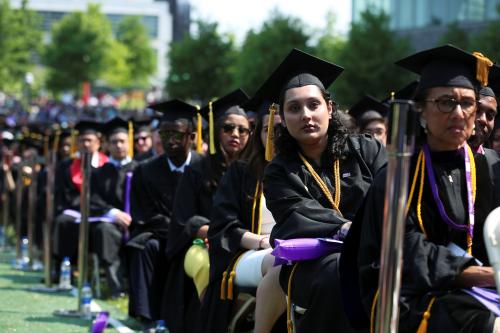The Advanced Placement (AP) program has been a staple of U.S. high schools for over a half-century. The College Board, a nongovernmental organization, created the AP program to provide college-level academic experiences for high school students. Now, with AP courses in dozens of subjects, nearly 23,000 high schools offer at least one AP course, with about 35% of recent high school graduates taking at least one AP course.
The AP program has been the subject of heated debate in recent weeks. As the College Board prepared to roll out a new AP course, AP African American Studies, Gov. Ron DeSantis decried the proposed curriculum for its emphasis on race and racism. That prompted efforts in Florida and other Republican-led states to block the course (and, potentially, other AP courses) unless the College Board agreed to major revisions. The College Board’s subsequent edits to the curriculum led to outcry that it had acquiesced to DeSantis and his colleagues to the detriment of U.S. students.
While the fate of AP African American Studies remains unclear, the public attention on that course has subsided a bit, which provides an opportunity to step back and consider broader questions about the AP program and College Board. The Brown Center invited three experts to weigh in on these questions: Suneal Kolluri, an assistant professor of education at the University of California-Riverside; Stephanie Owen, an assistant professor of economics at Colby College; and Jack Schneider, an associate professor of education at the University of Massachusetts-Lowell.
1. Why do we have AP courses in the first place? Should we be concerned that a nongovernmental organization, the College Board, has so much influence over public school curriculum?
Owen: The AP program was introduced just after World War II as an attempt to better coordinate content and curriculum between secondary and postsecondary schools. The hope was that doing so would increase the number of college entrants and graduates in the U.S., leading to a better-educated and more productive workforce. Today, the AP program serves several ostensible purposes. Students can save time and money by earning college credit or placing out of introductory courses, demonstrate academic rigor for the college admissions process, and—at least in theory—prepare themselves to succeed in college.
Schneider: The AP program was originally created as a way of accelerating learning for the so-called best and brightest. Designed by leaders from selective colleges and elite high schools, the vision squared with the Cold War-era concern about supplying human capital to counter the Soviet Union. Within a decade, though, savvy families were observing that participation in the AP program was giving students a college admissions edge. For them, it was less about academic acceleration and more about competitive advantage. Supporters of AP tend to like the idea that able and ambitious students can opt into more challenging work, but the real driver of AP growth over the years has been anxiety about college admissions, which has grown by orders of magnitude since AP was first created 70 years ago.
Kolluri: AP courses were developed to support “elite” students at prestigious boarding schools on the East Coast. AP would eventually become widely associated with rigor, and in recent years high schools have engaged in an “AP arms race” to offer as many of the courses as possible. Looking forward, though, I’d like to see a less centralized AP structure, with a focus on ensuring that teachers have what they need to design challenging learning experiences and assessments for their own students. Unfortunately, we have not built an educational system that prioritizes teacher expertise, and as such, the College Board is one organization among many with influence over our schools. However, given the extent to which we have outsourced control to nongovernmental organizations, I am less concerned about whether the College Board has power—and more concerned that it leverages that power to ensure equitable access to challenging academic content.
2. Who takes AP courses? Are they broadly accessible to students of different backgrounds?
Schneider: Once upon a time, the answer was pretty clear: White students at elite high schools took AP courses. Since then, things have changed—largely as a product of grassroots work by educators, which was then supported by broad and well-funded policy efforts. As a result, AP has grown dramatically and today serves roughly a third of eligible students. Of course, that doesn’t mean that AP participation is equitable, and gaps persist by race, ethnicity, and family income. Another equity gap is geographical in nature. To offer the kind of curricular differentiation that AP requires, you need a large enough student body to justify teaching multiple versions of the same kinds of classes; that just isn’t possible in a lot of rural areas.
Owen: In 2021, 2.5 million students in nearly 23,000 high schools took AP exams. While the vast majority of schools offer AP courses, these courses are not equally available to all students. Black, Latinx, and low-income students are underrepresented in AP courses. When schools introduce new AP courses, gaps in access tend to widen further, with already advantaged students more likely to take AP courses when they become available.
Kolluri: AP classes have been expanding to serve more students, including those from marginalized backgrounds. Still, they are not always equitably accessible. For example, as schools serving working-class students have added AP courses, schools serving middle- and upper-class students have expanded their offerings at a more rapid rate. I do think it’s notable, though, that many Latinx students participate in AP Spanish courses. That speaks to the capacity of culturally relevant curricula to invite marginalized students to academic rigor. I am hopeful the AP African American Studies course might encourage more Black students to try AP classes.
3. What are the effects of taking AP courses? Do these courses tend to increase college entry, persistence, or graduation (or reduce the coursework needed for graduation)?
Owen: Although students who take AP courses or exams tend to have better outcomes than those who don’t, knowing the “effect” of AP requires more careful analysis. The types of students and schools who participate in AP tend to be higher achieving to begin with, so it would be naïve to conclude from simple comparisons that AP causes students to do better in college. The best causal evidence suggests that AP can benefit students—increasing their college entry and degree attainment, decreasing time-to-degree, improving earnings, and swaying students towards certain majors. Importantly, however, the positive effects of AP are largely tied to taking and doing well on the associated exams. Simply taking AP courses without taking and passing the exams seems to have no effect on outcomes. This matters because a significant proportion of students who take an AP course do not take the associated exam, and many who take the exam do not receive a passing score. The disparities between course- and exam-taking are particularly pronounced for the most disadvantaged students. Any push to expand AP access without additional incentives and supports for students to succeed on exams is unlikely to combat inequality or improve outcomes.
Schneider: In addition to AP’s effects on academic outcomes, there’s the question of how taking AP courses affects students in the college admissions process. After a surge in the late 20th century, in which more AP courses was always better, the edge provided by AP began to dull. And that’s largely a product of successful work by equity advocates who wanted to see the program expanded beyond the students and schools AP had largely been serving in its first few decades. If everyone has AP on their transcripts, then it isn’t so special anymore, is it? To me, that’s the most interesting piece—the tension between these two deeply American impulses in education: to foster equal opportunity, on the one hand, and to stratify it on the other.
4. Are there changes you would like to see to the AP program or how we approach high school curriculum?
Kolluri: To its credit, the College Board has made many changes to the AP program that education experts suggested. This includes encouraging more project-based approaches, forms of assessment, and entry-level STEM opportunities. And yes, it has added AP African American Studies, a course highlighting the rich cultures and histories of the Black community. These revisions will likely enhance the effectiveness of the program and invite more students to engage in challenging academic content. Certainly, though, more could be done. First, more culturally relevant approaches—demonstrated to improve outcomes for students of color—might be embedded across the AP curricula. For instance, little in AP economics or AP environmental science considers race or communities of color. Teaching these disciplines without addressing the racial and cultural dynamics of the economy and environmental justice will fail to connect to students from marginalized communities. Also, AP might expand efforts to pare down curricular content, focusing more on deep learning.
Importantly, however, AP is not the only way to prepare for life after high school. More schools are introducing dual enrollment opportunities, where students can take actual college courses while in high school. Career and technical education courses are also expanding, offering students challenging exposure to work-related curriculum.
The Brookings Institution is committed to quality, independence, and impact.
We are supported by a diverse array of funders. In line with our values and policies, each Brookings publication represents the sole views of its author(s).










